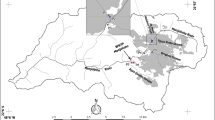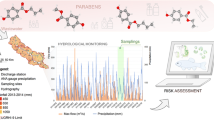Abstract
This article reports the first identification of paraben-chlorinated derivatives in river water. Parabens are widely used as preservatives in pharmaceuticals and personal care products. Parabens can be easily chlorinated by chlorinated tap water. The resulting chlorinated derivatives might pose a higher potential risk to humans and ecosystems than the corresponding parent parabens. However, the occurrence of such derivatives in rivers remains unknown so far. We studied 23 parabens and their chlorinated derivatives from rivers receiving effluents from sewage treatment plants in Shizuoka city, in the central Pacific region of Japan. The compounds were extracted by solid-phase extraction with a styrene polymer sorbent, trimethylsilyl-derivatized, and then identified by gas chromatography–mass spectrometry. Six chlorinated parabens and their primary degradation products, two chlorinated hydroxybenzoic acids, were found for the first time in river water. Moreover, in river water, chlorinated derivatives preferentially partition into the suspended-solid phase.



Similar content being viewed by others
References
Barceló D, Petrovic M (2007) Pharmaceuticals and personal care products (PPCPs) in the environment. Anal Bioanal Chem 387:1141–1142. doi:10.1007/s00216-006-1012-2
Benijts T, Lambert W, Andre DL (2004) Analysis of multiple endocrine disruptors in environmental waters via wide-spectrum solid-phase extraction and dual-polarity ionization LC-ion trap-MS/MS. Anal Chem 76:704–711. doi:10.1021/ac035062x
Canosa P, Rodríguez I, Rubí E, Negreira N, Cela R (2006) Formation of halogenated by-products of parabens in chlorinated water. Anal Chim Acta 575:106–113. doi:10.1016/j.aca.2006.05.068
Gallard H, Gunten U (2002) Chlorination of phenols: kinetics and formation of chloroform. Environ Sci Technol 36:884–890. doi:10.1021/es010076a
González-Mariño I, Quintana JB, Rodríguez I, Cela R (2011) Evaluation of the occurrence and biodegradation of parabens and halogenated by-products in wastewater by accurate-mass liquid chromatography-quadrupole-time-of-flight-mass spectrometry (LC-QTOF-MS). Water Res 45(20):6770–6780. doi:10.1016/j.watres.2011.10.027
Jianlong W, Ping L, Yi Q (1996) Biodegradation of phthalic acid esters by acclimated activated sludge. Environ Int 22:737–741. doi:10.1016/S0160-4120(96)00065-7
Kamaya Y, Fukaya Y, Suzuki K (2005) Acute toxicity of benzoic acids to the crustacean Daphnia magna. Chemosphere 59:255–261. doi:10.1016/j.chemosphere.2004.11.003
Lee H-B, Peart TE, Svoboda ML (2005) Determination of endocrine-disrupting phenols, acidic pharmaceuticals, and personal-care products in sewage by solid-phase extraction and gas chromatography–mass spectrometry. J Chromatogr A 1094:122–129. doi:10.1016/j.chroma.2005.07.070
Miller D, Wheals BB, Beresford N, Sumpter JP (2001) Estrogenic activity of phenolic additives determined by an in vitro yeast bioassay. Environ Health Perspect 109:133–138. doi:10.1289/ehp.01109133
Soni MG, Carabin IG, Burdock GA (2005) Safety assessment of esters of p-hydroxybenzoic acid (parabens). Food Chem Toxicol 43:985–1015. doi:10.1016/j.fct.2005.01.020
Steinberg DC (2010) Frequency of preservative use. Cosmetics Toiletries 125:46–51
Terasaki M, Makino M (2008) Determination of chlorinated by-products of parabens in swimming pool water. Int J Environ Anal Chem 8:911–922. doi:10.1080/03067310802272663
Terasaki M, Makino M (2009) Disinfection by-products of para-hydroxybenzoate esters (parabens): Synthesis and mass spectrometric study. J Health Sci 55:631–635. doi:10.1248/jhs.55.631
Terasaki M, Makino M, Tatarazako N (2009a) Acute toxicity of parabens and their chlorinated by-products with Daphnia magna and Vibrio fischeri bioassays. J Appl Toxicol 29:242–247. doi:10.1002/jat.1402
Terasaki M, Kamata R, Shiraishi F, Makino M (2009b) Evaluation of the estrogenic activity of parabens and their chlorinated derivatives by using yeast two-hybrid assay and the enzyme-linked immunosorbent assay. Environ Toxicol Chem 28:204–208. doi:10.1897/08-225.1
Wang L, Shen Z, Wang H, Niu J, Lian G, Yang Z (2009) Distribution characteristics of phenanthrene in the water, suspended particles and sediments from Yangtze River under hydrodynamic conditions. J Hazard Mater 165:441–446. doi:10.1016/j.jhazmat.2008.10.016
Westerhoff P, Yoon Y, Snyder S, Wert E (2005) Fate of endocrine-disruptor, pharmaceutical, and personal care product chemicals during simulated drinking water treatment processes. Environ Sci Technol 39:6649–6663. doi:10.1021/es0484799
Acknowledgments
This work was supported by the Grant-in-Aid for Young Scientists (B) No. 22750140 from the Ministry of Education, Culture, Sports, Science and Technology (MEXT), Japan.
Author information
Authors and Affiliations
Corresponding author
Rights and permissions
About this article
Cite this article
Terasaki, M., Takemura, Y. & Makino, M. Paraben-chlorinated derivatives in river waters. Environ Chem Lett 10, 401–406 (2012). https://doi.org/10.1007/s10311-012-0367-1
Received:
Accepted:
Published:
Issue Date:
DOI: https://doi.org/10.1007/s10311-012-0367-1




